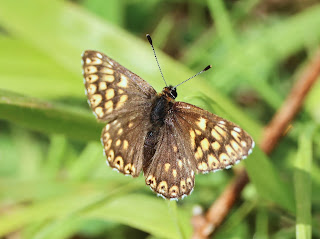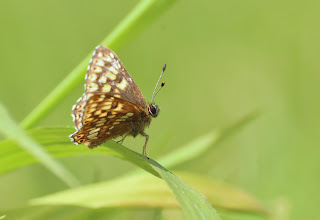Duke of Burgundy: This little beauty is found mainly in central southern England, although small freagmented colonies are found in the north of England particually in Yorkshire and Cumbria, witch Gait Barrows National Nature Reserve being one of the premier places in the north west to see them.
Despite its larger-than-life name the Duke of Burgundy is relatively small, with its upper surface brown with vivid orange spots it is unlikely to be confused with any other species found in the UK.
The larvae feed on the leaves of primroses and cowslips, transposing to winged adults in May and early June or occasionally a little later. The adult males of this now very rare butterfly species can be seen flying low over their territories, which are usually quite small areas of a few tens of square metres at the most; they defend their patches aggressively, seeing off invaders many times their size.
The Duke of Burgundy used to be classed as a Fritillary, due to its similar markings of pearly white spotted underwings , but it has now been identified as closer to the ‘
Metalmark’ family, the only one of its species found in the UK.
Gait Barrows National Nature Reserve is an extraordinary place with a rich mosaic of limestone habitats including unique limestone pavement, yew woodland, fen and is one of Britain's most important limestone landscapes.
Dingy Skipper: I couldn't resist a brief stop off at Warton Crag on the way home, it's by far one of my favourite places. Its absolutely stunning here looking out over Morecambe Bay and its limestone cliffs, decorated by wildflowers and colonised by rare butterflies.
One of which was there dingy skipper, a nationally scares butterfly who's larval food plant is the birdsfoot trefoil. There were dozen on the wing along the western side of the crag.
Brimstone: I also saw my first for the year pearl-bordered fritillary although it refused to settle for me I entertained myself with this brimstone which was feeding on the red campion. The Brimstone has a most exquisite wing shape, perfectly matching a leaf when roosting overnight or hibernating within foliage.







